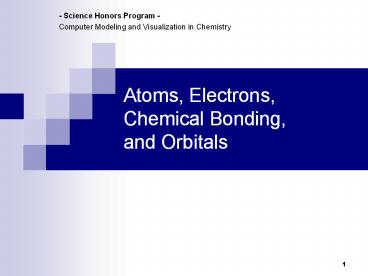Atoms, Electrons, Chemical Bonding, and Orbitals - PowerPoint PPT Presentation
Title:
Atoms, Electrons, Chemical Bonding, and Orbitals
Description:
- Science Honors Program - Computer Modeling and Visualization in Chemistry Atoms, Electrons, Chemical Bonding, and Orbitals * * As the energy of the MOs increases ... – PowerPoint PPT presentation
Number of Views:268
Avg rating:3.0/5.0
Title: Atoms, Electrons, Chemical Bonding, and Orbitals
1
Atoms, Electrons, Chemical Bonding, and Orbitals
- Science Honors Program - Computer Modeling and
Visualization in Chemistry
2
This presentation is for educational, non-profit
purposes only. Please do not post or distribute
this presentation to anyone outside of this
course. Many of the graphics in this
presentation are from Bruice, Paula Yurkanis.
Organic Chemistry, 4th Ed. Prentice Hall,
2003. http//wps.prenhall.com/wps/media/objects/72
4/741576/ McMurry, John Fay, Robert. Chemistry,
4th Ed. Pearson Education, 2003. http//wps.prenh
all.com/wps/media/objects/602/616516/
3
(No Transcript)
4
Ionization Energy of Atoms
5
Electronegativity
Ionization Energy (IE) amount of energy
necessary to remove an electron from a neutral
atom.Electron Affinity (EA) amount of energy
released when an atom absorbs an extra
electron.Electronegativity Average of above
two properties for an isolated atom.
What type of bond will form between two atoms?1.
Ionic 2. Covalent 3. Polar covalent
6
Ionic Bond
7
Covalent Bonding
An electron density plot for the H2 molecule
shows that the shared electrons occupy a volume
equally distributed over BOTH H atoms.
Potential energy (kJ/mol)
Electron Density for the H2 molecule
8
Polar Covalent
Percent Ionic Character of Diatomic Molecules
Molecule Ionic Ionic Molecule Ionic Ionic
H2 0 CsF 70
CO 2 LiCl 73
NO 3 LiH 76
HI 6 KBr 78
ClF 11 NaCl 79
HBr 12 KCl 82
HCl 18 KF 82
HF 41 LiF 84
NaF 88
HF has a polar covalent bond. It has a dipole
moment.
The difference in electronegativity between the
two bonded atoms determines the ionic character
(or covalent character) of the bond.
9
What is an Atom?
Protons and neutrons make up the heavy, positive
core, the NUCLEUS, which occupies a small volume
of the atom.
10
Photoelectric Effect
Photoelectric Effect the ejection of electrons
from the surface of a substance by light the
energy of the electrons depends upon the
wavelength of light, not the intensity.
11
Atomic Orbitals Wave-particle duality.
Traveling waves vs. Standing Waves. Atomic and
Molecular Orbitals are 3-D STANDING WAVES that
have stationary states.
Example of 1-D guitar string standing wave.
12
Atomic Orbitals How do electrons move around
the nucleus?
Density of shading represents the probability of
finding an electron at any point. The graph shows
how probability varies with distance.
Wavefunctions ?
Since electrons are particles that have wavelike
properties, we cannot expect them to behave like
point-like objects moving along precise
trajectories. Erwin Schrödinger Replace the
precise trajectory of particles by a wavefunction
(?), a mathematical function that varies with
position Max Born physical interpretation of
wavefunctions. Probability of finding a particle
in a region is proportional to ?2.
13
s Orbitals
Wavefunctions of s orbitals of higher energy have
more complicated radial variation with nodes.
Boundary surface encloses surface with a gt 90
probability of finding electron
14
electron density
wave function
radial probability distribution
15
p orbitals 3 p orbitals l 1,
ml 1, 0 -1
16
d orbitals Five d orbitals l 2, ml
2, 1, 0 - 1, -2
17
Atomic Orbital Hybridization sp
18
Atomic Orbital Hybridization sp2
19
Atomic Orbital Hybridization sp3
20
Covalent Bonding
s - bond e- density in the bond is distributed
symmetrically about the bond axis. p - bond e-
density in the molecular orbital has a nodal
plane that contains the bond axis.
21
s bondH2
22
s bond H2
23
s bondp-orbitalend-to-endF2
24
s bondmixedHCl CH4
25
Lone Electron Pairs
26
p - bond
p-orbital bonding side-to-side
27
Double Bonds Examples
Double bonds consist of 1 s and 1 p bonds in
these molecules. Double Bond Bond Order 2
Allene
Ethene
28
Triple Bonds
Triple bonds consist of 1 s and 2 p
bonds. Triple Bond Bond Order 3
Ethyne (acetylene)
29
Valence Bond Theory vs. Molecular Orbital Theory
For Polyatomic Molecules Valence Bond Theory
Similar to drawing Lewis structures. Orbitals
for bonds are localized between the two bonded
atoms, or as a lone pair of electrons on one
atom. The electrons in the lone pair or bond do
NOT spread out over the entire molecule. Molecula
r Orbital Theory orbitals are delocalized over
the entire molecule. Which is more correct?
30
Delocalization Resonance Structures
Benzene
OR
31
Benzene
The six MOs of benzene showing lobe phases and
relative energies.
32
Visualization Surfaces
Electron Density Surface Electrostatic Potential
Map
Electrostatic Potential Maps of Hydrogen Halides
33
Exercise
Atoms. Do a 1 electron atom such as H, or
He, then do multi-electron atom Do quantum
calculation. Visualize orbitals. What is
the 1st IE of the molecule? Pick a binary
compound. Verify with me if molecule makes
sense. Do quantum calculation. Draw
electron density surface Draw electrostatic
potential map. Is molecule polar? What is
electronegativity difference between atoms?
Find bond length. Bond order? Visualize the
orbitals. Which ones are bonding,
anti-bonding? Which are sigma, which are pi?
What is the 1st IE of the molecule? Do same as
above for a polyatomic molecule, such as benzene
Not too big, or well wait for ever for the
calculation. Verify with me if molecule makes
sense.






























